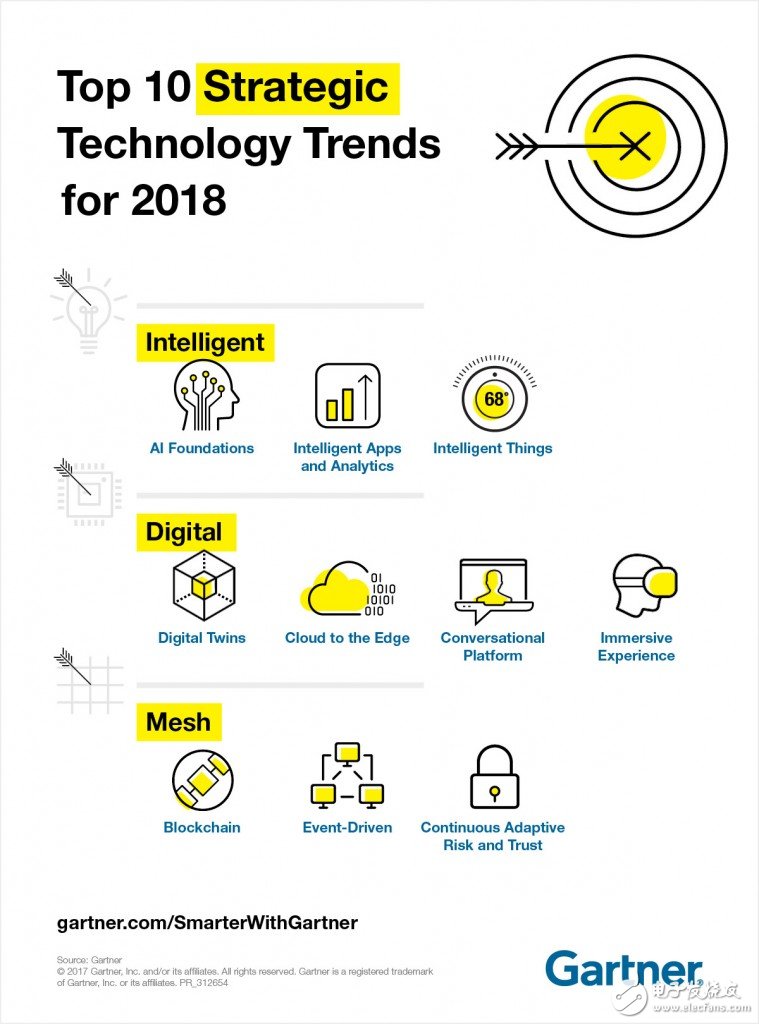Technology is continuously enhancing our daily lives, and the best approach is to keep up with the rapid changes in society. As fields like AI, IoT, and immersive experiences continue to evolve, it's essential to stay informed about these high-potential technologies. By doing so, we can better understand future developments. This article highlights the top ten technology trends that were worth watching in 2018. Let’s dive in!
**The Most Important Technology Trends of 2018**

As you can see, these top ten trends fall into three main categories: artificial intelligence, digital technology, and networking. Want to learn more about these groundbreaking innovations? Keep reading!
**1. AI Foundations (AI Foundations)**
According to a Gartner survey, around 59% of organizations were still in the early stages of gathering data to build their AI strategies in 2018. It was expected that by this year, AI would be increasingly used to improve decision-making, enhance customer experiences, and reshape business models.
**2. Intelligent Apps and Analytics (Intelligent Apps and Analytics)**
In the coming years, every application and service is expected to incorporate AI to some degree. By 2018, it was predicted that most smartphones would have dedicated AI chips. These chips would gradually become part of everyday life, almost as natural as breathing, making their presence almost invisible.
Smart applications would introduce a new "smart layer" between users and systems, changing how we work and interact. Enhanced analytics powered by AI would also play a crucial role in enterprise operations.
**3. Intelligent Things (Intelligent Things)**
By combining AI with machine learning, smart devices will be able to interact more seamlessly with people and their surroundings. Devices like Amazon Echo and Google Home are already transforming how we live, and more smart devices will soon be capable of working independently or responding to user input.
**4. Digital Twins**
Digital twins refer to the digital representation of physical assets using advanced technology. They can monitor real-time data through sensors and provide insights into the performance, location, and condition of the asset. In essence, a digital twin is a virtual clone that uses data to simulate real-world behavior.
With an estimated 21 billion connected sensors by 2020, digital twins are set to become a major trend in 2018. Industries such as marketing, healthcare, and urban planning will benefit from this shift toward digitalization.
**5. Cloud to the Edge**
Edge computing involves processing data closer to where it's generated, rather than sending it all to the cloud. This allows for faster response times and reduces latency. While cloud computing centralizes data storage and processing, edge computing brings computation and data analysis closer to the source.
Rather than being competitors, cloud and edge computing can work together to create more efficient and responsive systems.
**6. Conversational Platforms (Conversational Platform)**
The concept of “conversation as a platform†represents a new way of interacting with technology. Instead of relying on graphical interfaces, users will engage with systems through natural language. This new interface enables users to discover, access, and exchange information through dialogue.
These platforms are becoming more sophisticated, allowing them to handle complex interactions and evolving user needs over time.
**7. Immersive Experiences**
VR (Virtual Reality), AR (Augmented Reality), and MR (Mixed Reality) are creating more engaging and interactive experiences. MR combines elements of both VR and AR, allowing digital and physical objects to coexist and interact in real time.
Microsoft, Apple, and Google have all invested heavily in these technologies, with MR and AR becoming key areas of focus in the coming years.
**8. Blockchain**
Blockchain is the foundational technology behind Bitcoin and has emerged as a revolutionary innovation. Although it faced challenges in 2017, its potential was undeniable. By 2018, blockchain had gained more attention and was seen as a promising technology with wide-ranging applications.
**9. Event-Driven Systems**
Events are critical in business, as they reflect significant changes and status updates. With the rise of AI and IoT, businesses can now detect and analyze events more efficiently. By 2020, it was predicted that 80% of digital solutions would rely on event-driven approaches.
**10. Continuous Adaptive Risk and Trust (CARTA)**
As cyber threats grow more complex, organizations need better ways to manage risks. CARTA enables real-time risk assessment and trust evaluation, integrating security into DevOps to create a continuous DevSecOps process.
This approach emphasizes ongoing monitoring, adaptive responses, and secure access control, ensuring that organizations can protect themselves against evolving threats.
HP Chromebook X360 11 G3 EE,HP Chromebook X360 11 G3,HP Chromebook X360 11 G3 keyboard,HP Chromebook X360 11 G3 Palmrest
S-yuan Electronic Technology Limited , https://www.syuanelectronic.com